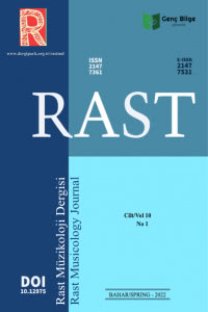Balina Şarkısı: Kambur Balina Megaptera Novaeangliae Kültürlerinde Müzikal Pratikler
müzik, zoomüzikoloji, balina şarkısı, kambur balina, vokal öğrenme
Whale Song: Musical Practices in the Cultures of the Humpback Whale Megaptera Novaeangliae
music, zoomusicology, whale song, humpback whale, vocal learning,
___
- Adam, O., Cazau, D., Gandilhon, N. vd. (2013) “New Acoustic Model for Humpback Whale Sound Production”, Applied Acoustics 74 (2013) 1182–1190.
- Allen, J. A., Garland E. C., Dunlop R. A., Noad M. J. (2018) “Cultural Revolutions Reduce Complexity in the Songs of Humpback Whales”, Proc. R. Soc. B 285: 20182088.
- Arraut, E. M., Viellilard J. M. (2004) “The Song of The Brazilian Population of Humpback Whale Megaptera Novaeangliae, in the Year 2000: Individual Song Variations and Possible Implications”, Annals of the Brazilian Academy of Sciences, 76(2): 373-380.
- Cholewiak, D. M., Sousa-Lima R. S. (2013) “Humpback Whale Song Hierarchical Structure: Historical Context and Discussion of Current Classification Issues”, Marine Mammal Science, 29 (3): 312-332 (July 2013).
- Clapham, P. J. ve Mead, J. G. (1999) “Megaptera novaeangliae”, Mammalian Species No. 604, 1-9.
- Clapham P. J. (2002) “Humpback Whale - Megaptera Novaeangliae”, Encyclopedia of Marine Mammals, (ed.) William Perrin, Bernd Würsig, J. G. M. Thewissen, Academic Press, California, USA, 589-592.
- Darling, J. (2002) “Song”, Encyclopedia of Marine Mammals, (ed.) William Perrin, Bernd Würsig, J. G. M. Thewissen, Academic Press, California, USA, 1124-1126.
- Doolittle, E. ve Gingras, B. (2015) “Quick Guide: Zoomusicology”, Current Biology 25, 5 October 2015, 811-812.
- Fournet, M. E. H. (2014) Social Calling Behavior of Southeast Alaskan Humpback Whales (Megaptera Novaeangliae): Classification and Context, yayımlanmamış yüksek lisans tezi, Oregon State University, Oregon, ABD.
- Garland, E. C., Goldizen, A. W., Rekdahl, M. L. vd (2011) “Dynamic Horizontal Cultural Transmission of Humpback Whale Song at the Ocean Basin Scale”, Current Biology 21, April 26, 2011, 687-691.
- Garland, E. C., Rendell, L., Lamoni L. vd. (2017) “Song Hybridization Events During Revolutionary Song Change Provide Insights into Cultural Transmission in Humpback Whales”, PNAS, July 25, 2017, vol. 114, no. 30, 7822–7829.
- Herman, L. M. vd (2013) “Humpback Whale Songs: Who Sings?”, Behavioral Ecology and Sociobiology (2013) 67: 1653-1663.
- Janik, V. (2014) “Cetacean Vocal Learning and Communication”, Current Opinion in Neurobiology, 2014, 28:60–65.
- Kavanagh Ailbhe S. vd. (2016) “Evidence for The Functions of Surface-Active Behaviors in Humpback Whales (Megaptera Novaeangliae)”, Marine Mammal Science, 33(1): 313-334.
- Marcedo, E., Herman L., Pack A. (2005) “Song Copying by Humpback Whales: Themes and Variations”, Animal Cognition (2005) 8: 93-102.
- Martin, S., Aniceto, A. S., Ahonen, H. (2021) “Humpback Whale (Megaptera novaeangliae) Song on a Subarctic Feeding Ground”, Frontiers in Marine Science, May 2021, Vol. 8.
- Martinelli, D. (2005) “A Whale of a Sonata - Zoomusicology and the Question of Musical Structures”, S.E.E.D. Journal, September 2005, Volume 5, No. 1, s. 2-29.
- Martinelli, D. (2007) Zoosemiotics: Proposals for a Handbook, Imatra: International Semiotics Institute.
- NMFS (National Marine Fisheries Service) (1991) Recovery Plan for the Humpback Whales (Megaptera novaeangliae). Prepared by the Humpback Whale Recovery Team for the National Marine Fisheries Service, Silver Spring, Maryland, 105 pp.
- Noad, M. J., Cato, D.H. vd (2000) “Cultural Revolution in Whale Songs”, Nature, Vol. 408, 30 November 2000, 537.
- O’Dell, C. (2021) “Songs of the Humpback Whale”, Library of Congress, (https://www.loc.gov/static/programs/national-recording-preservation-board/documents/humpback%20whales.pdf) (Erişim Tarihi: Ağustos 2021).
- Payne, R. S., McVay, S. (1971) “Songs of Humpback Whales”, Science, 13 August 1971, Volume:173, Number 3997, pp. 585-597.
- Perrin, W. F., Würsig, B., Thewissen J. G. M. (2002) Encyclopedia of Marine Mammals, (ed.) William Perrin, Bernd Würsig, J. G. M. Thewissen, Academic Press, California, USA.
- Whitehead, H. ve Rendell, L. (2015), The Cultural Lives of Whales and Dolphins, The University of Chicago Press, Chicago and London.
- Welch, C. (2021) “Balina Sırları” National Geographic, Özel Sayı: Okyanuslar, Mayıs 2021, 34-65.
- Link 1: International Whaling Commission: “Humpback Whale - Megaptera novaeangliae” https://iwc.int/humpback-whale
- Figür 1: Hawaii Marine Mammal Consortium https://www.hmmc.org/Song/HBWsong.html
- Figür 2: Hawaii Marine Mammal Consortium https://www.hmmc.org/AudioGallery/AudioGallery.htm
- ISSN: 2147-7361
- Yayın Aralığı: Yılda 4 Sayı
- Başlangıç: 2013
- Yayıncı: Genç Bilge Yayıncılık (Young Wise)
The Effect of Playing Instrument on Voice Training
Meslek yüksek okulu öğrencilerinin ruhsal durum algıları ile müzik tercihlerinin incelenmesi
Gonca SOYSAL, N. Fikri SOYSAL, Elçin BALCI
Vokalist mi yoksa oyuncu mu: Müzikal tiyatro türünde hangisi daha iyi performans göstermeye hazır?
Marina KRUGLOVA, Anna SHCHERBAKOVA, Aigul GAREEVA, Alexander VASİLENKO
Balina Şarkısı: Kambur Balina Megaptera Novaeangliae Kültürlerinde Müzikal Pratikler
Preludes and fugues for piano in the polyphonic works of Chinese composers
Marianna CHERNYAVSKA, Mengzhe ZHANG
Shqipe AVDIU-KRYEZİU, Arsim AVDİU
V.R.'nin “Game” şarkısının taslak versiyonlarında özne-nesne ilişkileri kavramı. Tsoy
Çocuğun sosyalleşme süreci olarak yaratıcı sanatsal ve müzikal etkinliği
Irina Vladimirovna WAGNER, Ekaterina Mikhailovna AKİSHİNA, Elena Petrovna OLESİNA
